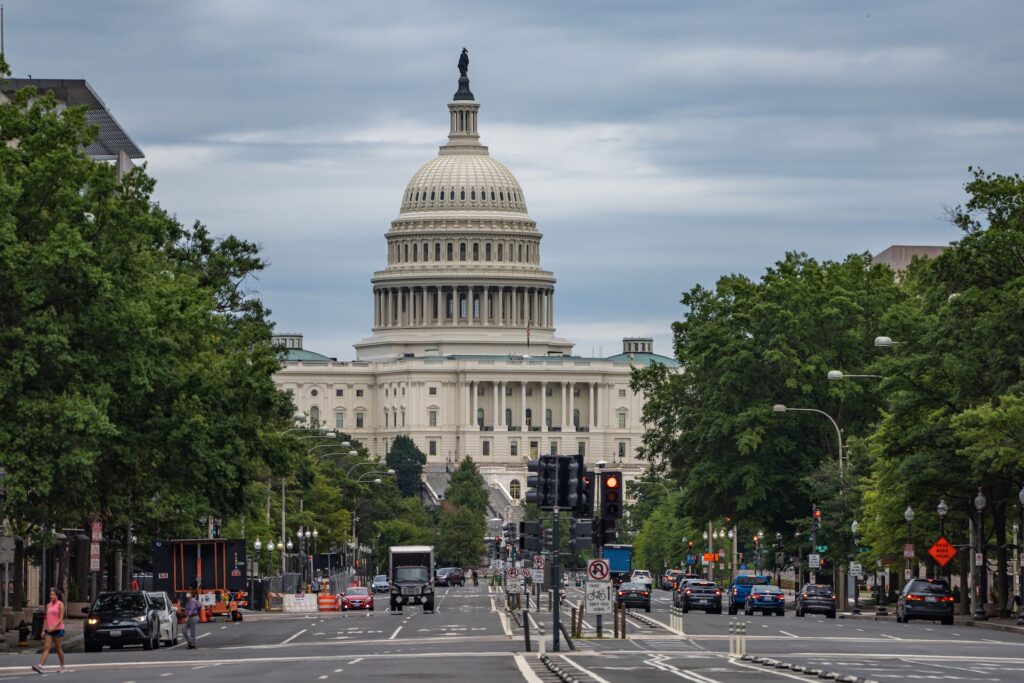The negative economic effects of Russia’s invasion of Ukraine are being felt around the world. Here in the United States, Americans face rising gas and food prices, with more trickle-down consequences on the way. The majority of Americans have been supportive of the Biden administration’s response to the Ukraine crisis.[1] The latest Russian invasion has made it clear how important American leadership is to the most foundational aspect of our foreign policy—keeping the homeland, and our allies, safe. As long as Americans see a threat to the country’s security, support for the administration’s effort to manage the crisis likely will continue. But what happens if the economic costs Americans would bear in exchange for these security policies become too high for them to pay?
The support of the American people for standing up to Putin is fortunate, especially if the world moves further towards a multipolar global order. Such an order would require the assemblage and maintenance of economic and security blocs that would share benefits and wield power to protect their individual and collective interests. Multipolarity likely also would mean more conflict, less growth, more poverty, greater wealth inequality both within and among nations, and the scarcity of critical commodities, including food, with profound destabilizing, adverse effects.[2] American leadership abroad would be vital in negotiating this transition and mitigating its effects—but that leadership will require the support of the American people.
The Biden administration focused on this requirement when it conceived of a foreign policy for American workers designed to create conditions for domestic prosperity and garner support for the country’s international leadership.[3] The approach relies on the belief that economics should be central to US foreign policy, just as it is to domestic policy. As Secretary Blinken said in his inaugural speech as Secretary of State, “distinctions between domestic and foreign policy have simply fallen away. Our domestic renewal and our strength in the world are completely entwined.”[4] But a foreign policy designed along these lines necessarily depends upon domestic policies that promote economic opportunity for all Americans. This our domestic policy has not done for a very long time. Americans increasingly recognize this reality, which threatens to imperil their continuing support for the country’s foreign policy, especially when it requires them to sacrifice.
There is cause for concern for the support of the American people for the country’s foreign policy. A majority of Americans report feeling more fearful than hopeful about what lies ahead for themselves, the country, and the world.[5] Some politicians, pundits, and economists have expressed puzzlement concerning their pessimism, citing what they believe to be the “force of the current recovery.” For example, The Washington Post recently reported that a January 2022 Gallup poll, taken before the invasion of Ukraine, found that 82 percent of Americans believe the country is on the “wrong track.”[6] The article asserts Americans “refuse to believe” the country is doing well, citing a growth rate in 2021of 5.7 percent, the highest it’s been in almost 40 years; unemployment of only 4 percent; a 40 percent reduction in child poverty; fewer bankruptcies; and a record pace for the creation of new businesses.[7]
Perhaps most concerningly, the American people’s pessimism extends beyond the present. The Pew Research Center reported in March 2021 that a majority expects that in the coming decades income inequality will increase, the economy will weaken, the environment will deteriorate, and health care will be less affordable. Over 80 percent of the population believe robots and computers will do much of the work Americans now do.[8] Even 72 percent of CEOs worry about losing their jobs.[9]
Against this backdrop, the possible emergence of a multipolar world is unfolding, and these conditions likely will determine the sustainability of American support for the Biden administration’s foreign policy efforts. For this reason, the government must seek to understand why so many Americans think negatively about the future. Are Americans disillusioned with the economy, are their views of reality disconnected from the actual facts (as the Post article suggests), or does another phenomenon explain their attitudes? Much depends on the answer to these questions. Indeed, more than the United States’ standing as a global leader hangs in the balance; as the corrosive politics in the country recently has made clear, the dissatisfaction among so many Americans threatens to put our own democracy at risk.
The simple truth is the economy no longer works for a majority of the American people, and has not for at least the last fifty years. Consider the wages of production and non-supervisory American workers, whom comprise 80 percent of the US labor force. The average wage in 1968, adjusted for inflation, was $24.18.[10],[11] Yet their average pay today is $26.94, an increase of only 10 percent.[12] Said simply, 80 percent of American workers have not seen a meaningful pay increase for fifty years. and any wage increases some workers have realized have been offset by rising prices. Inflation-adjusted, average pay for all production and nonsupervisory workers has declined by nearly 2 percent during the past year.[13] This wage stagnation drives the pessimism among many working-class Americans about their economic futures.
Numerous possible explanations exist for the wage stagnation experienced by American workers, but all have faults. One recent study from the Bureau of Economic Research attributes the stagnation to “labor-market concentration,” in which too few employers are competing for workers, making lateral movements by employees difficult, thus enabling business to pay lower wages.[14] Another theory focuses on the alleged effects of globalization, which has made cheap foreign goods more available and devastated or concentrated much of the U.S. manufacturing and retail sectors. Others have blamed technology. But none of these explain why the wages of American workers have been so low for so long, or why corporate America and the government have failed to reward and protect workers during a sustained period of increased economic growth and productivity. A more credible reason for wage stagnation can be found elsewhere—in the pay increases other Americans have enjoyed during the same time period.
The wage statistics reflect that corporate America only has left hourly and non-supervisory workers behind, not CEOs and top wage earners. CEOs have seen their compensation grow 1322 percent since 1978. The ratio between their income and workers’ wages increased from a ratio of 21–1 in 1965 to 351–1 in 2020. The story is similar for the top 1 percent of wage earners, who realized a gain of 341 percent between 1978 and 2019.[15] Meanwhile, the equity markets, which have risen an average of 12.25 percent per year since 1978, have benefited only the relatively few Americans who have been able to invest in them.[16] Only 32 percent of all Americans have 401(k)s.[17] But even this number is misleading, as a record 89 percent of the shares in the stock market are owned by the wealthiest 10 percent of American households.[18] Furthermore, the wealthy Americans have been helped by a dramatic reduction in their taxes. The highest marginal tax rate in 1970 was 71.75 percent; today it is 37 percent.[19] Similarly, the capital gains rate was 30 percent in 1970 compared to 20 percent today.[20]
This huge disparity between non-supervisory wage earners and shareholders provides a more credible explanation why the wages of most American workers have been stagnant for so long, and why they are so pessimistic. Profitability has not been shared, and as a result, the country has experienced a significant and widening opportunity gap. For example, children born into families in the bottom fifth of income distribution have only a 7.5 percent chance of making it into the top fifth.[21] And those born into the top economic fifth have twice as much chance of being in the middle class as adults as those born into the bottom fifth.[22] Higher education, long seen as the principal way of achieving a more secure economic future, increasingly is linked to parental economic success.[23] The obvious prescription is to provide financing help to those who want a college education but cannot afford it. Yet the idea of providing free, need-based college tuition lacks bipartisan support; while largely supported by Democrats and left-leaning independents, the majority of Republicans and conservative independents oppose the idea.[24] Nor is the opportunity gap limited to education. The government also has failed to adequately fund vocational training, healthcare, childcare, and housing.
Our private and public sector leaders have allowed this to happen. It was a choice. The income inequality between wealthy and working-class Americans began with decisions made by the private sector. Our political leaders followed suit by failing to adopt policies designed to make all working-class members full economic participants in the economy or to take meaningful steps to help them succeed. Senator Mitt Romney’s remarks during the 2012 presidential campaign help explain this problem. Romney claimed his job “is not to worry about [the] 47%…who are dependent on government…[and] believe they are entitled to health care, food, and housing, to you-name-it…”[25] In fact, the last administration failed to do any of the following: propose legislation to provide health care for the American people, as it promised to do; pass an infrastructure bill, as it promised to do; improve the lives of working-class Americans, such as by raising the minimum wage, as it promised to do; or move to protect Americans from COVID-19, as it promised to do. What the Trump administration did do is pass the largest single tax cut for corporations and wealthy Americans in the country’s history.
The failure to include American workers as full participants in the economy threatens US leadership abroad. Economic instability increases vulnerability to isolationist narratives, which some politicians amplify for their own electoral purposes. Thus, they wrongfully blame immigrants and vilify outsiders. This disquieting reaction has reoccurred throughout history. The initial “America First Committee,” the precursor to Trump’s “America First” policy, sought to isolate America after Nazi Germany invaded France. Fortunately, the Roosevelt administration recognized that a world dominated by Germany and Japan would pose serious risk to the security and economic interests of the United States. America’s interests would be similarly compromised now should we withdraw from international institutions and miscalculate what is in the country’s long term best interests, allowing China and Russia to reshape the global order to suit their purposes. The wealth and wellbeing of every American will be determined by how well America leads as a new world architecture emerges.
What can we do to encourage public support United States leadership abroad? First, we must accept that the wage stagnation suffered by American workers acts as a threat to our national security, and any administration seeking to manage the emerging global order to the benefit of the American people will be hampered without public support. In addition, we need an antidote to the isolationist impulses stoked self-servingly by some political leaders. The disinformation they use to redirect blame for the circumstances in which American workers now find themselves, as well as potential for future disinformation, must be discredited for US prosperity and security.
But we also need practical prescriptions for how to close the wage and opportunity gaps that have opened over the last fifty years. Some are obvious: higher wages for non-supervisory workers; childcare and early childhood education; more funding for public education; providing affordable healthcare and housing assistance; making college and vocational school more affordable by providing tuition and other financial support; and using the anti-trust laws to expand the number of employers, giving employees more employment options and greater bargaining power.
Other helpful measures appear less frequently in popular discourse. Some have argued for incentivizing businesses to boost the wages of American workers by tying net corporate taxes to whether companies share earnings equitably with workers.[26] Requiring corporations to maintain a certain ratio between the wages of non-supervisory workers as compared with the compensation of executive and supervisory personnel would be one way of doing so. It also could be made a precondition for bidding on government contracts. The Securities Exchange Commission should require companies to disclose this ratio, which would be useful to investors and set the stage for adopting such measures. Americans and businesses should embrace building better economic architecture given the competitive landscape ahead, which will ignite multiple challenges that will require intergovernmental cooperation and broad public support.
The war in Ukraine has shown that America’s future depends upon the preservation of a peaceful international order. The Biden administration’s reinvigoration of NATO, and the leadership it has shown in confronting Russian aggression, especially given the inaction of the Chinese Communist Party, has provided an opening for the renewal of US leadership abroad. But that leadership will founder, and the international order will weaken, if we continue to leave Americans behind at home. The present pessimism of so many Americans is a warning the country needs to act to make all Americans full economic participants in the country’s future.
[1] Patsy Widakuswara, “What’s Behind American Support for Ukraine?,” VOA News, April 29, 2022, https://www.voanews.com/a/what-s-behind-american-support-for-ukraine-/6551539.html.
[2] KNC, “Globalization is dead and we need to invest a new world order,” The Economist, June 28, 2019, https://www.economist.com/open-future/2019/06/28/globalisation-is-dead-and-we-need-to-invent-a-new-world-order.
[3] US Department of State, “A Foreign Policy for the American People,” press release, March 3, 2021, https//www.state.gov/a-foreign-policy-for-the-american-people/.
[4] US Department of State, “A Foreign Policy.”
[5] David Nather, “Exclusive poll: America’s fears rise for 2022,” Axios, December 31, 2021, https://www.axios.com/america-fears-rise-2022-poll-e6684bee-e6bf-41be-919a-caf4cf9fb951.html.
[6] Fareed Zakaria, “Our economy is doing well – but many Americans refuse to believe it,” The Washington Post, February 10, 2022, https://www.washingtonpost.com/opinions/2022/02/10/biden-strong-economy-that-americans-wont-believe/.
[7] Zakaria, “Our economy is doing well.”
[8] John Gramlich, “Looking ahead to 2050, Americans are pessimistic about many aspects of life in U.S.,” Pew Research, March 21, 2019, https://www.pewresearch.org/fact-tank/2019/03/21/looking-ahead-to-2050-americans-are-pessimistic-about-many-aspects-of-life-in-u-s/.
[9] Kate Marino, “Top CEO worry for 2022: Job security,” Axios, December 27, 2021, https://www.axios.com/ceos-worried-job-security-2022-6663d8a7-c42e-48a3-b4a8-ce6f88e7b13b.html.
[10] “Average Hourly Earnings of Production and Nonsupervisory Employees, Total Private,” FRED Economic Data, last updated April 1, 2022, https://fred.stlouisfed.org/series/AHETPI.
[11] “Calculate the Value of $2.94 in 1968,” Dollar Times, last updated 2022, https://www.dollartimes.com/inflation/inflation.php?amount=2.94&year=1968.
[12] FRED Economic Data, “Average Hourly Earnings.”
[13] Department of Labor Bureau of Labor Statistics, Average Weekly Hours, Hourly Earnings, and Weekly Earnings–Private Nonagricultural Industries (Washington: US Government Publishing Office, 2022), https://www.govinfo.gov/content/pkg/ECONI-2022-02/pdf/ECONI-2022-02-Pg15.pdf.
[14] Efraim Benmelech, Nittai K. Bergman, and Hyunseob Kim, “What’s Causing Wage Stagnation in America?” Kellogg Insight, December 2, 2019, https://insight.kellogg.northwestern.edu/article/wage-stagnation-in-america.
[15] Lawrence Mishel and Jori Kandra, “CEO pay has skyrocketed 1,322% since 1978,” Economic Policy Institute, August 10, 2021, https://www.epi.org/publication/ceo-pay-in-2020/.
[16] Ian Webster, “S&P 500 Returns since 1978,” Official Data Foundation, last updated 2022, https://www.officialdata.org/us/stocks/s-p-500/1978.
[17] Maurie Backman, “Does the Average American Have a 401(k)?,” The Motley Fool, June 19, 2017, https://www.fool.com/retirement/2017/06/19/does-the-average-american-have-a-401k.aspx.
[18] Robert Frank, “The wealthiest 10% of Americans own a record 89% of all U.S. stocks,” CNBC, October 18, 2021, https://www.cnbc.com/2021/10/18/the-wealthiest-10percent-of-americans-own-a-record-89percent-of-all-us-stocks.html.
[19] “Historical Highest Marginal Income Tax Rates,” Tax Policy Center, last updated February 9, 2022, https://www.taxpolicycenter.org/statistics/historical-highest-marginal-income-tax-rates.
[20] Sean Williams, “A 95-Year History of Maximum Capital Gains Tax Rates in 1 Chart,” The Motley Fool, May 30, 2018, https://www.fool.com/retirement/2017/02/11/a-95-year-history-of-maximum-capital-gains-tax-rat.aspx.
[21] Raj Chetty, “Improving Opportunities for Social Mobility in the United States,” Penn Institute for Urban Research, May 15, 2014, https://penniur.upenn.edu/publications/improving-opportunities-for-social-mobility-in-the-united-states.
[22] Isabel V. Sawhill, “Higher Education and the Opportunity Gap,” Brookings Institution, October 8, 2013, https://www.brookings.edu/research/higher-education-and-the-opportunity-gap/.
[23] Sawhill, “Higher Education and the Opportunity Gap.”
[24] Hannah Hartig, “Democrats overwhelmingly favor free college tuition, while Republicans are divided by age, education,” Pew Research Center, August 11, 2021, https://www.pewresearch.org/fact-tank/2021/08/11/democrats-overwhelmingly-favor-free-college-tuition-while-republicans-are-divided-by-age-education/.
[25] John Christoffersen, “Romney’s ‘47%’ chosen as year’s best quote,” USA News, December 14, 2012,https://www.usatoday.com/story/news/nation/2012/12/09/romneys-47-percent-chosen-as-years-best-quote/1756833/.
[26] “Raise America’s Pay: A Game Changing Economic Proposal,” The Project to Raise America’s Pay, last accessed May 5, 2022, https://www.raiseamericaspay.org/working-paper.




